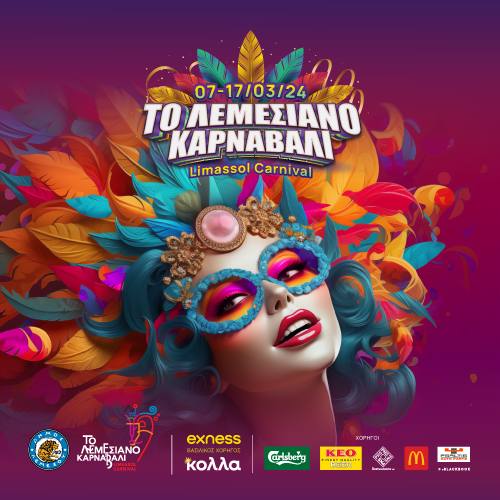- Our City
-
Our Municipality
- Δημοτικό Διαμέρισμα Μέσα Γειτονιάς
- Departments and Services
- Sports Office
- European Projects
- Social Programs
- Centre for Support and Reintegration SCHEDIA
- Municipal Open School
- Εκδηλώσεις Δήμου
- Educational Programs
- Blue Limassol Forum
- Πρόγραμμα Net Zero Cities
- Blue Innovation Center
- Twinned Cities
- Προϋπολογισμός Δήμου 2024
- Λεμεσός 2030 - Υποψήφια Πόλη
- Πολιτιστική Στρατηγική
- Our Mayor
- Our Municipal Council
- For Our Citizens
- Developing Projects
- Εnvironmental Αctions
- Career
The Limassol Carnival
Νo other city can compete with Limassol for Carnival
It is for this reason that they all visit Limassol without fail during this period. It is a festival that is keenly awaited by young and old alike. It all started with groups of merrymakers from all social strata of the city, who used to organize gatherings in their homes with fun being the sole purpose. The wine flowed plentiful and when the fun was high, they would go out into the streets setting up spontaneous parades with donkeys, carriages, carts and bikes mocking people and circumstances related to their daily lives.
The spontaneity and romanticism of that era may have been lost over the years, but the need for people to have wholehearted fun and to escape from reality even for a short time, through the fanciful disguises, remains the same. The people of Limassol learn at a very young age to love Carnival because, for each and every one, it is associated with moments of joy. It is the time that everybody is eagerly awaiting to abandon for a while the social norms and go out into the streets dressed up in funny costumes with their main concern to have a nice time. The climax of the festivities is the day of the King Carnival, the day when a huge carnival parade takes place and it is justly considered as the “Festival of Limassol”. The Limassol spirit remains immortal as the older generations, make sure to transmit their passion and love of Carnival, to the younger generations. This is the unique moment that everybody places a pause to everyday concerns and worries. Whatever the problems and the difficulties, Limassol Carnival, will always be an escape into carefreeness.
A timeless chapter in the history of the Limassol Carnival is the troubadours (in Greek “Cantadori”), that is groups of men with their guitars who used to walk around the streets, stand under the balconies and entertain the city's residents with their serenades. Even today, that the distances are longer, they remain faithful to the tradition. Wearing their elaborate and flamboyant costumes, they tour the city in groups, either sitting in their engine drawn chariots or on foot, reminding the people of Limassol the unforgettable moments of the past. As for the legendary dances, which used to take place in homes and cinema halls, they have long since moved to the luxurious ballrooms of the city's hotels.
Besides private initiatives, Limassol Municipality tries to maintain and carry on to the greatest extend, the traditional celebration of Carnival, by organizing a festive period of eleven days, that includes among other events, parades, outdoor balls, fancy dress competitions and visual art exhibitions. As in the old times, the official day for the start of the Carnival, is Tsiknopempti (Stinking Thursday). On that day, the citizens of Limassol gather at various locations in the historical center, where they revive traditional customs, such as 'tsiknoma' (barbecued meat eating), serenades and impromptu feasts. The events reach their climax on the two weekends of Carnival and Tyrini, with the organization of the children's parade and the grand parade, respectively, in which thousands of carnivalists participate.

Limassol Carnival 2025 Information
General
The Limassol Carnival is the oldest and most popular folk festivity in Limassol ...
History of the Carnival
Although the Carnival festive season has been chronicled in Cyprus ....
Modern days carnival
In Limassol the Carnival festivities are carried on from generation to generation as part of family tradition...
Main characteristics
To this day, the Carnival remains a strong urban and family tradition for the people of Limassol...
Techniques and skills
Limassol Carnival requires the transfer of technical know-how and skills from one generation to the next...
The history of the Mask
The origin of the Mask can be traced back to ancient and mysterious religious ceremonies...
Serenades
To this day, the serenades and carnival songs remain the characteristic sounds of Limassol...





